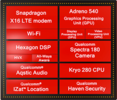Qualcomm Snapdragon 835 (8998) vs HiSilicon Kirin 960
Qualcomm Snapdragon 835 (8998)
► remove from comparison
The Qualcomm Snapdragon 835 Mobile Platform (MSM8998) is a high-end SoC for smartphones (mostly Android based) that was released early 2017. Its one of the first processors that is manufactured in 10 nm (LPE FinFET at Samsung). The SD835 is the successor to the Snapdragon 821.
It integrates 4x Kryo 280 at 2.45 GHz (max) for performance and 4x Kryo 280 at 1.9 GHz (max) for efficiency. Furthermore offers an X16 LTE modem, 802.11a/b/g/n/ac/ad WiFi, a dual-channel 32-Bit 1866 MHz LPDDR4x memory controller, an UFS 2.1 controller, Hexagon 682 DSP, Spectra 180 Image Seonsor Prozessor, Bluetooth 5.0, GPS, GLONASS, Baeidou, Galileo Satellite Support.
HiSilicon Kirin 960
► remove from comparisonThe HiSilicon Kirin 960 is an ARM based high-end octa-core SoC for smartphones and tablet, which was introduced with the Huawei Mate 9 in November 2016. Besides 8 CPU cores (4x Cortex-A73, 4x Cortex-A53), the SoC is also equipped with a modern Mali-G71 MP8 graphics adapter, a dual-channel LPDDR4 memory controller as well as an LTE Cat. 12/13 modem. It is one of the fastest ARM SoCs in the end of 2016. The Kirin 960 is manufactured in a modern 16-nm process at TSMC.
| Model | Qualcomm Snapdragon 835 (8998) | HiSilicon Kirin 960 |
| Codename | Kryo 280 | Cortex-A73/-A53 |
| Series | Qualcomm Snapdragon | |
| Clock | 2450 MHz | 2400 MHz |
| Cores / Threads | 8 / 8 | 8 / 8 |
| Transistors | >3000 Million | |
| Technology | 10 nm | 16 nm |
| Features | X16 LTE Modem, Adreno 540 GPU, Hexagon DSP, Spectra 180 Camera, Aqstic Audio, IZat Location, Haven Security | ARM Mali-G71 MP8 GPU, 4x Cortex-A73 (2.4 GHz) + 4x Cortex-A53 (1.8 GHz, big.LITTLE), 2x 32 Bit LPDDR4 Memory Controller |
| iGPU | Qualcomm Adreno 540 ( - 710 MHz) | ARM Mali-G71 MP8 ( - 900 MHz) |
| Architecture | ARM | ARM |
| Announced | ||
| Manufacturer | www.qualcomm.com |
Benchmarks
Average Benchmarks Qualcomm Snapdragon 835 (8998) → 100% n=20
Average Benchmarks HiSilicon Kirin 960 → 91% n=20
* Smaller numbers mean a higher performance
1 This benchmark is not used for the average calculation











